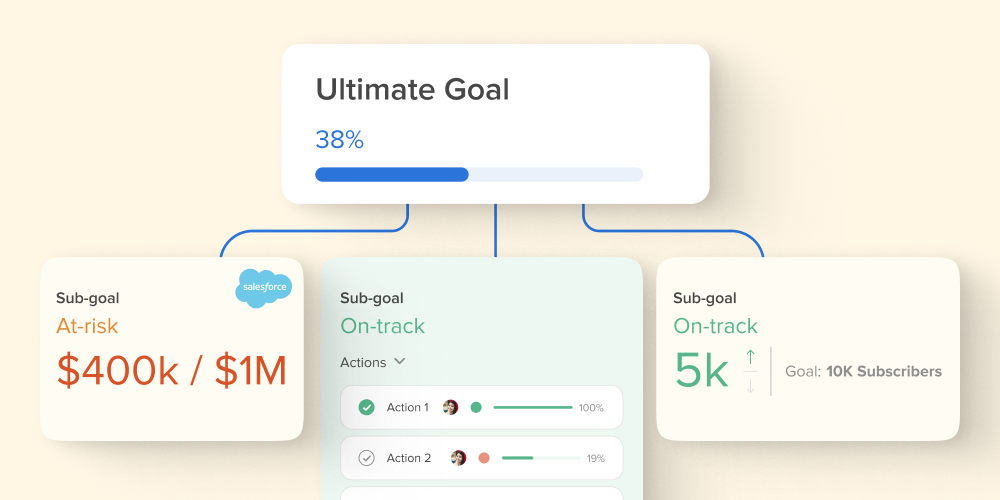From new businesses to old businesses, building out key performance indicators (KPIs) is a key component in your business’s success (or failure). To help you out, I’ve compiled a collection of great marketing KPI examples that you can implement into your business and track for success.
The Importance of Tracking Marketing KPIs
A KPI is a metric that helps you track and measure progress toward your business goals. Essentially, it is a tool you use to see if your marketing efforts are paying off. They are used to identify and track the performance of marketing campaigns, strategies, and tactics.
Correctly tracking these KPIs will help you measure the success of your marketing efforts and identify any areas for improvement.
I like to think of KPIs as measures of progress toward achieving your defined goals, which are integral to ensuring your product or service is moving in the right direction. But it doesn’t end there. KPIs can help you take a quick glance at some metrics that will gauge the health of your marketing strategy and campaigns. You can pull quick reports to see if your project is trending up or down, and KPIs provide you with the tools you need to pivot if required.
With so much riding on successful monitoring of marketing KPIs (it is your business rise or fall, after all), it pays to keep the focus on some of the most important ones, and that’s exactly what I’ve compiled for you below. This list has some of the most popular marketing KPIs, as well as a few tools you can use to track them.
Popular Marketing KPI Examples & How To Measure Them
With so many metrics available to track, it can be overwhelming. But these are popular KPIs for a reason. They are both impactful and important to gauge your business health. Some popular KPIs to track include:
- Website Traffic
- Return on investment (ROI)
- Lead generation
- Conversion rate
1. Website Traffic
Understanding your website traffic is one of the most crucial marketing KPIs. You can capture excellent data and insight into your target market by tracking how many people visit your website and the path they take to get there.
This data provides an invaluable glimpse into your website’s popularity, and the channels users use to access it. When you know where and how users are accessing your product, you can help target them more effectively to get the best return on investment (ROI) for campaigns, giving you great insight into how successful marketing campaigns can be.
Content is one of the key elements to help drive users to websites, making it a crucial aspect of traffic acquisition. You can also work with a growth marketing agency to help analyze all of your data, ensure your content process is optimized and drive as much traffic to your website as possible.
2. Return on Investment (ROI)
Return on investment (ROI) is the amount of money you earn from a marketing campaign compared to the amount you spend on the campaign. If you have been in client or stakeholder meetings, the term “what’s the ROI” will most likely be dropped somewhere in the conversation.
ROI is an important metric to track because it helps you determine the effectiveness of your marketing campaigns and whether it is generating a positive return.
To track ROI, you need to calculate the revenue generated by a marketing campaign and subtract the cost of the campaign. You can then divide the result by the campaign cost to get the ROI. Also, if you are tracking ROI, remember to track it from the beginning of the campaign and don’t start halfway through. Accurate numbers will give you the best view of your campaign’s success.
3. Lead generation
Without leads, you won’t be able to generate any sales. Period.
However, there are multiple practices that you can track for lead generation, and you don’t need to choose just one. To get the most out of a lead generation strategy, you should dive into specific metrics like cost per lead (CPL), conversion rate, and lead volume.
CPL tells you how much money you’re spending on lead generation activities, conversion rate gives insight into what percent of leads become customers, and lead volume is essential for understanding how your number of qualified leads changes over time. You should try to track all three of these together to help ensure that your lead-generation operations are successful, cost-effective, and have a positive ROI.
4. Conversion rate
Conversion rate is like the holy grail of marketing metrics – if your goal is to maximize conversions, then understanding and monitoring this KPI is key. Conversion rate indicates how effectively customers are taking the actions you want them to take so they convert. Conversions can be anything from filling out a form, purchasing, or signing up for a newsletter.
The conversion rate is calculated by dividing the number of successful transactions over a specific period by the total number of potential customers. Knowing what conversion rate you need to aim for will ensure that your marketing efforts provide tangible results and real value while helping you stay on track with optimizing and refining your acquisition channels.
Additionally, tracking lead generation KPIs is crucial for understanding how effectively your marketing efforts are generating leads. Without leads, you won’t be able to generate any sales. Period. Therefore, it’s important to dive into specific metrics like cost per lead (CPL), conversion rate, and lead volume to ensure the success and efficiency of your lead generation strategy.
Best practices for setting & tracking KPIs
You must establish KPIs to establish the effectiveness of any marketing strategy. Of course, not all KPIs are created equally – but when it comes to setting and tracking KPIs, there are best practices to follow. Such as:
- Determining a few realistic yet ambitious KPIs that you can use to gauge the success of your strategies.
- Set measurable goals and break down your long-term objectives into smaller goals that make financial and practical sense.
- Stay organized and keep track of progress with clearly labeled dashboards for easy evaluation.
Taking the time to do this can go a long way toward increasing ROI and greater success in future campaigns. Investing in a KPI dashboard software is a great way to keep track of all your metrics and KPIs in one single place.
Using Hive to track KPIs

If you’re looking for a way to measure the success of your marketing efforts, KPIs are a great metric. Whether it’s tracking page visits, conversion rates, or user retention – being able to track these numbers can help your business make informed decisions about marketing campaigns.
Many tools are at your disposal to make your KPI tracking straightforward. Investing in a project management platform like Hive will offer you a fleet of features that can help you streamline your marketing efforts and track your KPIs more effectively.
Hive is a powerful project management platform with features designed to help teams work collaboratively and efficiently. Its intuitive interface makes it easy to navigate, and its integrations with popular marketing tools like Google Analytics ensure you can track all your essential KPIs in one place.





